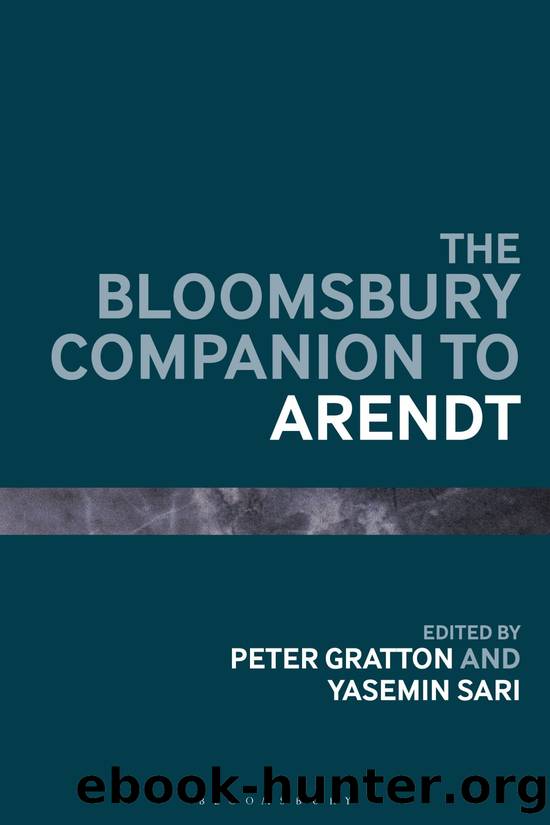The Bloomsbury Companion to Arendt by Peter Gratton & Yasemin Sari

Author:Peter Gratton & Yasemin Sari [Gratton, Peter & Sari, Yasemin]
Language: eng
Format: epub
Tags: History, Jewish, Philosophy, Political, Political Science, History & Theory, Individual Philosophers, History & Surveys, Modern, Social Science, Jewish Studies, Feminism & Feminist Theory
ISBN: 9781350053304
Google: V4vzDwAAQBAJ
Publisher: Bloomsbury
Published: 2020-10-01T21:11:18+00:00
33
Natality and the Birth of Politics
Anne OâByrne
The thought of natality begins to take shape very early in Arendtâs workâas early as her doctoral dissertation, Love and Saint Augustine (1929). It appears there under the name âbirthâ and comes into its own only later as the condition of natality until The Human Condition (1958). âBirthâ refers to the moment when we appear out of our mothersâ bodies, but for Arendt, natality is always something more: our being created, our emergence from the negative condition of not yet being, our first appearance in the world, the opening to new beginnings, our being between past and future, our shared plurality, and the signal of our capacity for action, responsibility, and revolution. If we think of Arendt as a phenomenologist, we see her encountering birth as something we witness and experience in the world. Approached as a phenomenon, from various points of view in various parts of her work, natality is eventually revealed as an ontological structure of human being and, controversially, the key to understanding political life.
For Arendt, a thesis on Augustine was an occasion for working through, among other things, the questions of time and existence inherited from Heidegger, with whom she had studied in the years during which he wrote Being and Time. While Heidegger in that work devoted himself to the study of ours as a futural mode of being, Arendt retrieved his attention to both ânot yetâ and âhaving beenâ as ways of being in time, that is, both the âwhenceâ and âwhitherâ of our existence.
In The Human Condition, natality is prominent from the start. When each of us is born, the world has never seen anyone quite like us before, and this natal newness is intimately linked to the human condition of plurality. The difference is what we share. Yet, so far, this is just first birth, the material condition for the possibility of being in the world, but, as such, just part of the cycle of life and death that Arendt identifies in terms of the Greek word zÅÄ, or mere life. This is the life we share with animals, and it characterizes human life insofar as that life remains subject to the cyclical time of the natural world. We labor and consume, are born, give birth, die, endure hardships, and also enjoy the sheer bliss of being alive. If we hanker after something more here, something like immortality, the desire is fulfilled in the joy of having children and grandchildren grow up around us, and death comes in ripe old age in the midst of an enduring clan, as it did for the patriarchs of the Hebrew Bible.
Yet, if the ancient Hebrews understood their lives in terms of their inherited traditions, and if the Romans saw themselves as being born in order to make themselves worthy of their ancestors, Arendt sees us moderns taking up a thought of second birth that has Christian and Greek roots. The structure is familiar as rebirth in Christ, the incarnate,
Download
This site does not store any files on its server. We only index and link to content provided by other sites. Please contact the content providers to delete copyright contents if any and email us, we'll remove relevant links or contents immediately.
The remains of the day by Kazuo Ishiguro(8381)
Tools of Titans by Timothy Ferriss(7807)
Giovanni's Room by James Baldwin(6806)
The Black Swan by Nassim Nicholas Taleb(6761)
Inner Engineering: A Yogi's Guide to Joy by Sadhguru(6439)
The Way of Zen by Alan W. Watts(6288)
Asking the Right Questions: A Guide to Critical Thinking by M. Neil Browne & Stuart M. Keeley(5355)
The Power of Now: A Guide to Spiritual Enlightenment by Eckhart Tolle(5330)
The Six Wives Of Henry VIII (WOMEN IN HISTORY) by Fraser Antonia(5234)
Astrophysics for People in a Hurry by Neil DeGrasse Tyson(4998)
12 Rules for Life by Jordan B. Peterson(4160)
Housekeeping by Marilynne Robinson(4059)
The Ethical Slut by Janet W. Hardy(4036)
Skin in the Game by Nassim Nicholas Taleb(3965)
Double Down (Diary of a Wimpy Kid Book 11) by Jeff Kinney(3922)
Ikigai by Héctor García & Francesc Miralles(3889)
The Art of Happiness by The Dalai Lama(3844)
Skin in the Game: Hidden Asymmetries in Daily Life by Nassim Nicholas Taleb(3720)
Walking by Henry David Thoreau(3681)
